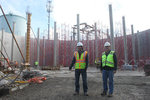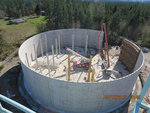To provide a clean, safe water supply, even in the event of an earthquake or other disaster, the City of Port Townsend is building a new 5 million-gallon water reservoir and state-of-the-art water …
This item is available in full to subscribers.
We have recently launched a new and improved website. To continue reading, you will need to either log into your subscriber account, or purchase a new subscription.
If you had an active account on our previous website, then you have an account here. Simply reset your password to regain access to your account.
If you did not have an account on our previous website, but are a current print subscriber, click here to set up your website account.
Otherwise, click here to view your options for subscribing.
* Having trouble? Call our circulation department at 360-385-2900, or email our support.
Please log in to continue |
|


To provide a clean, safe water supply, even in the event of an earthquake or other disaster, the City of Port Townsend is building a new 5 million-gallon water reservoir and state-of-the-art water filtration system.
Located at the end of Howard Street off Hastings Avenue, the new reservoir is going up next to a 1 million-gallon standpipe and a 37-year-old, 5 million-gallon reservoir, which was not designed for seismic events and is to be demolished once the new system is operational.
Estimated cost of the water treatment facility is $16 million. City water users, through rates and fees, will pay off low-interest loans from the Drinking Water State Revolving Fund ($9.3 million) and the Public Works Trust Fund ($6.9 million).
"If we had not been able to successfully get the loan package for this project, the cost to finance it conventionally would have cost an estimated $19 million more in interest," said David Timmons, city manager. "Also, one of the Drinking Water loans has a partial loan forgiveness, which makes it a grant. This grant effectively negates the interest on the other loans for the project."
To pay off the loans, water customers pay a capital surcharge of $18 per month, which could increase to $21 in 2018. "This may not be necessary if our project comes in under budget, which it currently is," Timmons said.
City drinking water comes from a 60-square-mile watershed in the Olympic National Forest that drains to the Big Quilcene and Little Quilcene rivers. Previous plans for a less expensive water-treatment system using ultraviolet (UV) light were changed because the Washington Department of Health requirements for monitoring and protecting that watershed from contamination would have resulted in similar overall costs.
The main contractor for the project is Stellar J Corp. Rob Wamstead is the project manager for the city.
HOW IT WORKS
Water has been brought to Port Townsend from City Lake at Eaglemount since 1928, said Ian Jablonski, the city's water system manager. At first, it was delivered to concrete reservoirs on Morgan Hill, replaced when a 5 million-gallon reservoir was built in 1979 off Howard Street.
"The water line splits off at the [Port Townsend Paper Corp.] mill, comes uphill behind Les Schwab [Tire Center], and comes up Howard Street, goes through the business park, comes up Rainier Street," Jablonski said.
That's "about 5,000 feet" of 24-inch, "ductile iron" pipes, fitted in "a bell-and-spigot-style connection," he said. "It's steel pipe ... fairly thick, and it's pretty earthquake resistant." That water line has been in operation since 1998, Jablonski said.
Gravity feeds water to the 7,000-square-foot treatment facility. It first goes through mechanical screens that filter particles slightly larger than a grain of salt, Jablonski said. Those preliminary screens protect the membrane filters, which are the heart of the new purification system.
There are going to be three membrane filter column skids in the facility. "Two of the skids will be operating simultaneously, with the third in a standby status," he said. Within the filter "skids" are columns – "they're basically PVC tubes" – filled with thousands of membranes that are "like little spaghettis." The water goes into the column and pushes into the fibers from the sides; the fibers are hollow in the center, and clean water comes out the top and bottom of the columns.
The membrane filters undergo a backwash cleaning approximately every hour, with air forced into the columns. The “spaghettis” are loose within the column, and wiggle around, Jablonski said. They filter out particles as small as 0.04 microns, and are designed to catch microbes such as giardia and cryptosporidium, a pathogen that's about 6 microns in size.
About once a week, the membranes are treated with sodium hypochlorite – liquid bleach – which helps remove organic material that collects on the filters.
"About once a month, you have to do a more thorough cleaning, using citric acid, which removes minerals, and sodium hydrochlorite in a hot-water solution. Wastewater is chemically neutralized and sent to the sanitary sewer system.
"The membranes are warrantied for a seven-year service life, and it will cost $178,500 to replace all 102 filter columns (204 total) in each of the two operating filter skids," Jablonski said.
The skids are made in Australia, and the control valves come from Colorado.
The facility includes a "chemical dosing room" as well as a laboratory, shop, mechanical room, electrical room, air-compressor system room, control room and an office for the two full-time operators working weekdays. At night and during the weekends, the computer-run system is checked remotely, Jablonski noted. The system includes an emergency diesel-powered generator and, for emergencies, "is designed so you could bypass the filter and run raw water into the storage reservoirs."
Because the reservoirs are situated atop a hill, gravity helps deliver water to downtown and points in between; Jablonski called downtown "the low zone." A new booster-pump station is also being built. There's already a booster pump on the campus of Port Townsend High School to provide water pressure for Morgan Hill.
HUGE RESERVOIR
With its tall, evenly spaced columns within, the massive simplicity of the half-finished reservoir calls to mind the Coliseum of Rome, or the Acropolis. The old reservoir is nearby, as is a taller, thinner 1 million-gallon standpipe, painted an unassuming green. The standpipe was built in 1995, the same year baffles, similar to interior plastic curtains, were added to the old 5 million-gallon reservoir.
Jablonski said the old reservoir wasn't designed to meet current seismic requirements.
Cost of the new reservoir and booster-pump station is estimated at $8 million, also paid for by loans from the Drinking Water State Revolving Fund ($6.9 million) and Public Works Trust Fund ($2.1 million), all to be repaid by utility rates and fees.
Jack Burns is in charge of the Skaar Construction team that is building the new tank. Thirty-nine feet tall and made of cement, the new tank looks much like the old one nearby, but is designed to withstand earthquakes. Like the old reservoir, it's situated just uphill from a wide valley of houses and people that could be harmed by a flood.
Brandon Maxwell was hired by the city as a civil engineer EIT in August 2015. He is currently the city's field inspector.
He said water-treatment plants are complex projects, with "mechanical processes, complicated electrical systems, civil infrastructure supplying all the water, all the drain lines. Seismic considerations."
The reservoir walls are 10 inches thick. The outside is wrapped in steel cable and covered with 2 inches of shotcrete. "A machine wraps the cables around and around, like an old barrel," Maxwell said. "Then you put shotcrete on the outside." Shotcrete is a concrete mixture. "You shoot it out of a gun."
The round wall is built in 11 sections, the concrete poured into a 45-by-40-foot rebar checkerboard, one of which was lying in wait in the mud on the morning of March 25, while the 45-by-39-foot yellow metal form stood in place next to the finished wall section. "They're very specialized forms," Maxwell said. "Skaar builds them ... they've got it down to a science. It's just beautiful to watch."
About 4.5 feet of concrete is placed into the form at a time. "They can only pour it so fast. They have to let the bottom of it set up." The brown grid of rebar has thin lengths of white PVC tubes that hold torsion cables to "create extra tension in the wall. Some of the way steel works is it gets stronger when you tension it," Maxwell explained. Epoxy grout is pumped into the PVC tubes near the bottom of the wall after the bars are tensioned.
The floor was poured in four sections, over seismic protection cables that are tied with wire into the rebar in the wall. "They're splayed out." The floor's wires sprout in fan shapes up from the floor. The walls sit on a neoprene pad, with a plastic water-stop strip.
"The wall and foundation move independently of each other in case of an earthquake," Jablonski added. "The seismic cables hold them together."
Inside are 32 2-foot-wide columns holding the roof up. Normally, you'd have rebar dowels embedded into the floor, Jablonski said. These are not attached. Some of the columns support a baffle wall that creates a flow path for water to travel in and out of the reservoir.
A perforated inlet pipe emerges from the floor that emits water, which then "snakes through the baffles," Jablonski said. There is an overflow drain pipe and a drain in the floor.
"People have asked if we sized the reservoir for the future," Timmons said. "The answer is yes. But we can only store so much treated water at any time for health reasons. Five million is about one week of water for the city."
The new reservoir, water-treatment facility and booster pump are scheduled for completion by late September.
For more information, visit ptdrinkingwaterprojects.wordpress.com.